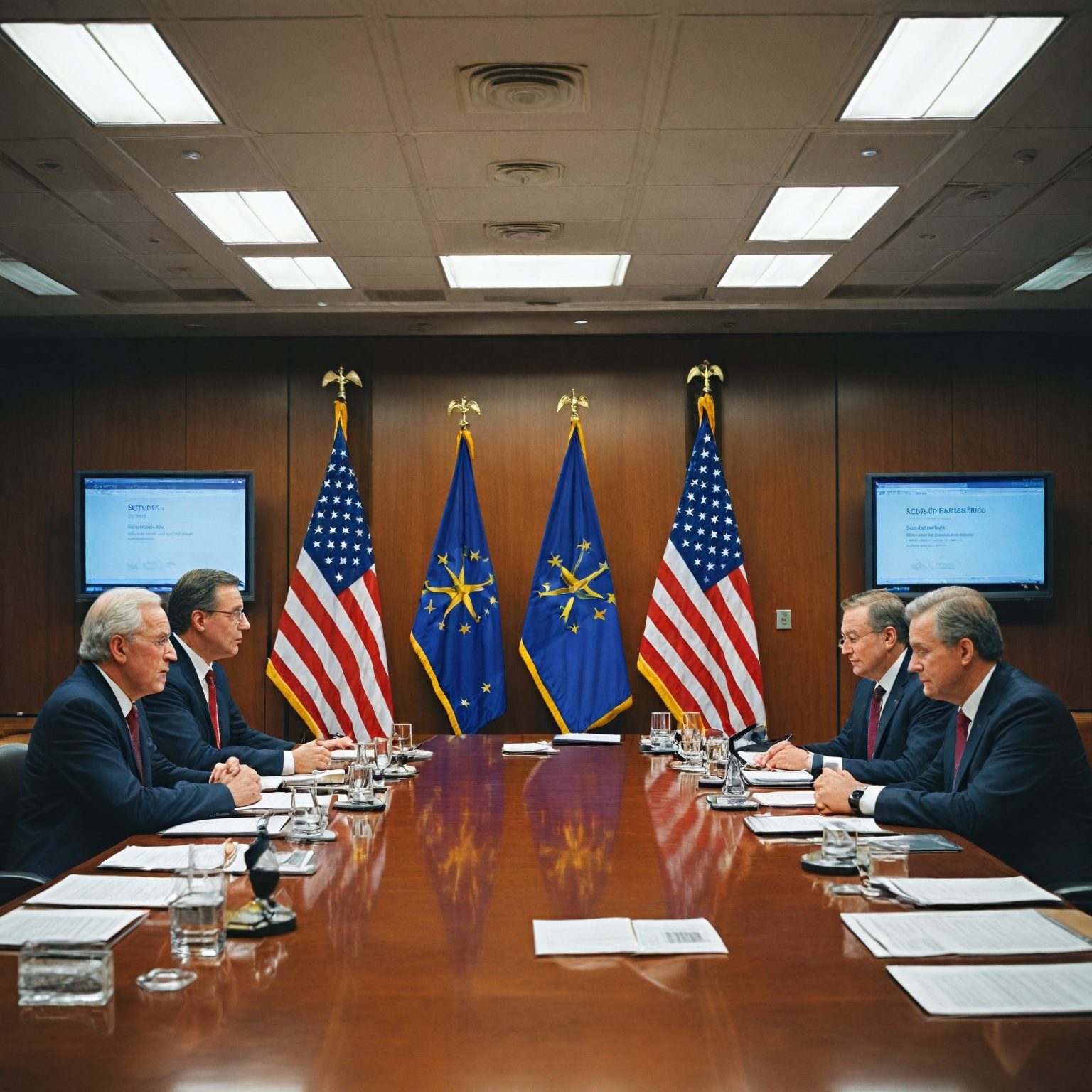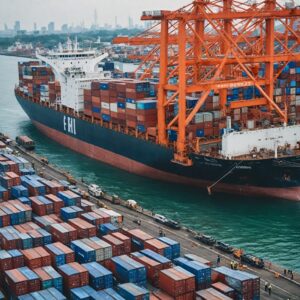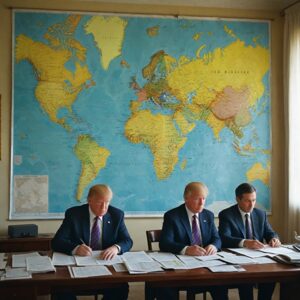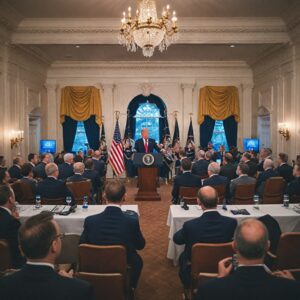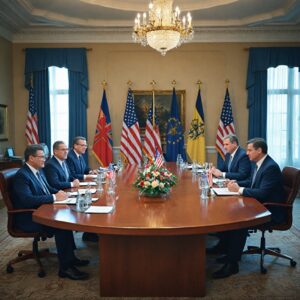Summary
The imposition of tariffs by the United States on European Union (EU) goods has significantly strained the longstanding transatlantic trade relationship, one of the world’s largest commercial partnerships valued at approximately €1.6 trillion in 2023. These tariffs, affecting key sectors such as steel, aluminum, textiles, luxury goods, and agricultural products, have prompted strong reactions from European companies and governments alike, with concerns about increased costs, disrupted supply chains, and reduced competitiveness in the US market. The EU has responded by initiating World Trade Organization (WTO) disputes and preparing retaliatory measures on U.S. imports worth around €26 billion, while also emphasizing a preference for negotiation over escalation.
European companies, particularly those in luxury goods, spirits, and manufacturing, have voiced apprehension about the tariffs’ impact on recovery prospects and market access, noting the difficulty of relocating production due to protected geographical indications and the challenge of competing amid redirected global trade flows. The tariffs have also introduced uncertainty that affects investment decisions and supply chain management, prompting some firms to consider reshoring or alternative sourcing strategies. Despite the challenges, sectors like pharmaceuticals have largely been shielded from tariffs, although the overall economic consequences remain mixed and contingent on future tariff developments and EU countermeasures.
Negotiations between EU and U.S. officials have been ongoing, intensified by threats from the U.S. administration to raise tariffs on EU goods from 20% to 50%, which accelerated European efforts to secure a trade deal. While the U.S. government defends tariffs as necessary for protecting national security and bolstering domestic manufacturing, European leaders emphasize the importance of resolving disputes through dialogue and warn against the broader negative effects of a prolonged trade conflict. Both sides have expressed willingness to cooperate, underscoring the critical importance of maintaining a strong transatlantic partnership amid complex geopolitical and economic challenges.
This evolving trade dispute highlights broader tensions in global trade governance and economic strategy, with significant implications for companies, consumers, and governments on both sides of the Atlantic. The European Commission’s readiness to pursue WTO litigation and the deployment of an anti-coercion instrument mark notable escalatory steps, while ongoing business lobbying and public discourse reflect the high stakes involved. The eventual outcome of the race for a comprehensive US-EU trade deal will be pivotal in shaping the future of transatlantic economic relations and addressing the uncertainties facing European companies amid shifting global trade dynamics.
Background
The transatlantic trade relationship between the European Union and the United States is one of the most significant commercial partnerships in the world, with EU-US trade in goods and services reaching approximately €1.6 trillion in 2023. This longstanding relationship, established formally in 1953 with U.S. diplomatic engagement with the European Coal and Steel Community, is underpinned by shared values, military cooperation through NATO, and strong economic ties. The European Union is also the largest buyer of U.S. natural gas and oil, a critical factor in ensuring energy security and coordinated responses to geopolitical challenges such as Russia’s military aggression against Ukraine.
Despite these strong ties, the relationship has faced increasing strain due to tariff disputes. The U.S. administration imposed tariffs on various European goods, including steel, aluminum, textiles, home appliances, and agricultural products, leading to tensions on both sides of the Atlantic. In response, the European Commission announced the initiation of a dispute at the World Trade Organization (WTO) concerning the U.S.’ “reciprocal” tariff policies and duties on cars and car parts, marking a significant escalation in trade disagreements.
European companies have expressed concern over the impact of these tariffs, particularly in sectors like luxury goods and spirits. For instance, Pernod Ricard’s U.S. exposure, accounting for about 19% of its total sales largely through Irish whiskey, vodka, and rum, faces challenges as tariffs affect recovery prospects and limit options for manufacturing relocation due to protected geographical indications. The EU has also indicated readiness to implement countermeasures covering U.S. goods worth around €26 billion ($28 billion) in retaliation.
Negotiations between EU and U.S. trade officials have been ongoing for months, aiming to avoid or mitigate the damaging effects of these tariffs. However, proposals to significantly increase tariff rates, such as from 20% to 50% on EU goods, have accelerated EU efforts to reach a deal. Despite these difficulties, European Commission President Ursula von der Leyen and other officials have maintained that Europe retains substantial leverage in trade, technology, and market size, leaving room for potential resolution.
Impact of US Tariffs on European Companies
The imposition of tariffs by the United States on European Union (EU) products has had a multifaceted impact on European companies, influencing trade dynamics, investment decisions, and sector-specific performance. In 2023, the EU experienced a €109 billion deficit in services trade with the US, despite maintaining a trade surplus in goods. The introduction of US tariffs, particularly the 25% duties on aluminium and steel imports announced in March 2025, has exacerbated challenges for many EU firms, prompting the EU to prepare “firm and proportionate” countermeasures, although some retaliations have been temporarily suspended.
European companies have faced direct cost increases due to these tariffs, which make their products more expensive and less competitive in the US market. This effect extends beyond bilateral trade: tariffs imposed by the US on other global partners risk redirecting products toward Europe, intensifying competition for EU companies and potentially disrupting supply chains. Uncertainty regarding tariff policies has also led to reduced investment by European firms wary of fluctuating trade conditions.
Certain sectors have been particularly vulnerable. The electrical machinery and equipment category, including smartphones and lithium-ion batteries, represents a major area of concern, with Chinese exports to the US worth approximately $124.8 billion in 2023—some of which may be diverted to the EU as a result of US tariffs, increasing competitive pressures on European producers. Personal luxury goods companies, such as LVMH, Kering, and Richemont, which collectively have about 20%-25% of their sales exposure to the US, face potential setbacks from tariff-induced price increases. While these companies may partially mitigate impacts through premium pricing given their affluent customer base, the aspirational segment is more vulnerable to reduced spending.
Pharmaceuticals, another significant sector, have so far been largely shielded from tariffs, with anticipated impacts limited assuming a 20% tariff scenario. Certain exclusions, such as copper, pharmaceuticals, semiconductors, and lumber, have been applied to some tariff rounds, though future adjustments remain possible. Other sectors affected by tariffs include passenger vehicles and medical appliances, with diagnostic reagents and gas turbines also listed among the most impacted products in early tariff schedules.
The broader economic consequences of tariffs have been mixed. A 2023 report by the U.S. International Trade Commission noted that tariffs on steel, aluminum, and Chinese goods have led to increased production in protected US industries but simultaneously caused declines in downstream sectors due to higher input costs. This dual effect is echoed in Europe, where the economic hit from tariffs will depend on the final tariff rates agreed upon and the EU’s responsive measures. Despite sector-specific vulnerabilities, the overall macroeconomic impact on Europe is expected to be limited, allowing for targeted redistributive policies to cushion the most affected industries.
Investment ties between the EU and the US remain robust, with €4.7 trillion in reciprocal investments as of 2023 supporting millions of jobs on both sides. However, tariff-induced trade tensions have generated considerable market volatility and uncertainty for European companies, prompting intense lobbying efforts to exclude key goods from tariff lists and efforts to negotiate a comprehensive US-EU trade deal that could stabilize transatlantic economic relations.
European Response to US Tariffs
The European Commission has adopted a measured but firm stance in response to the US steel and aluminium tariffs initially imposed during the Trump administration. While the EU formulated retaliatory measures targeting American products, these counter-tariffs were suspended as of 14 April 2025 in an effort to avoid further escalation and encourage negotiations. The Commission’s preference remains to reach a balanced and mutually beneficial trade agreement with the United States, emphasizing negotiation over a tit-for-tat tariff war.
In preparation for potential renewed US tariffs—including those announced on car imports—the European Commission has been consulting with member states on lists of US goods that could be subject to countermeasures. This consultation process includes products that have been under suspended tariffs since 2018 as well as new goods under consideration. The EU has also signaled readiness to bundle multiple retaliatory actions, which may extend beyond metals to areas such as intellectual property rights and licensing restrictions, utilizing the recently adopted but never previously used anti-coercion instrument as a “nuclear option” in trade disputes.
European leaders, including Commission President Ursula von der Leyen and French Trade Minister Laurent Saint-Martin, have repeatedly stressed the importance of safeguarding European workers, businesses, and consumers while expressing a clear preference for resolving disputes through dialogue rather than escalating tariffs. At the same time, the EU has prepared to launch formal dispute settlement procedures at the World Trade Organization (WTO), arguing that the US tariffs violate fundamental WTO rules and undermine the principle of internationally agreed trade regulations.
The uncertainty surrounding the US tariff regime has compelled European companies to reassess their supply chains, investment plans, and customer relationships, with some considering onshoring production to serve the US market or seeking alternative suppliers. While studies indicate that tariffs can promote reshoring and strengthen domestic industries in the US, the EU’s strategic response aims to balance firmness with the avoidance of a prolonged trade conflict that could harm both economies in the long term.
US Government Response to European Concerns
The United States government has taken a firm stance in response to the European Union’s concerns over tariffs and trade tensions. Following the imposition of 25% tariffs on European steel and aluminum, the EU announced its intention to impose retaliatory tariffs, including a proposed 20% tariff on European car imports. However, the U.S. White House clarified that the EU’s reciprocal tariff rate on cars was being paused amid ongoing negotiations. This pause came shortly after President Trump declared a 90-day pause on tariffs for most countries, while simultaneously increasing tariffs on China to 125%, underscoring a selective and strategic approach to tariff implementation.
The U.S. administration has defended the use of tariffs as a necessary tool to protect national security and strengthen domestic industries. Studies cited by U.S. officials claim that the tariffs introduced during President Trump’s first term led to significant reshoring in manufacturing and steel production, thereby boosting the U.S. economy and addressing economic and strategic objectives. Moreover, the U.S. government has implemented stricter customs procedures, including mandatory full customs clearance for packages valued above $250, affecting delivery times and costs for international e-commerce platforms. These measures highlight the administration’s commitment to enforcing trade policies that prioritize American economic interests, even as European companies voice concerns about the impacts of these tariffs.
Despite the rising trade tensions, U.S. officials have indicated a willingness to engage in dialogue with European counterparts. Continuous negotiations have been underway to avoid further escalation and to find a mutually beneficial resolution. However, the Trump administration’s threats to increase the reciprocal levy on EU goods from 20% to 50% accelerated EU efforts to solidify their negotiating position, complicating the path to an agreement. Nevertheless, there remains an expressed intent on the part of U.S. lawmakers and the incoming Biden administration to strengthen the transatlantic partnership through cooperation in areas such as trade, health, climate change, and security.
Race for a US-EU Trade Deal
The European Union and the United States have been engaged in intense negotiations aimed at reaching a trade agreement to avoid or mitigate the impact of tariffs imposed by the U.S. administration, particularly those announced under former President Trump. These tariffs have affected a wide range of EU goods, leading to reciprocal measures from the EU and creating significant tension in transatlantic trade relations.
EU trade officials have sought to limit the damage caused by U.S. tariffs, with negotiations accelerating after the U.S. threatened to increase tariffs from 20% to 50% on certain European imports. European Commission Vice-President Maroš Šefčovič expressed that a deal was close before these escalations, emphasizing the importance of a fair and balanced agreement that protects the daily trade flow valued at approximately 4.5 billion euros. The EU has shown a preference for negotiation over confrontation, advocating for a mutually beneficial outcome to avoid a full-scale tariff war, which French Trade Minister Laurent Saint-Martin also underscored as harmful to all parties involved.
In preparation for continued uncertainty, the European Commission has launched consultations on potential countermeasures and readied World Trade Organization (WTO) litigation to respond to the U.S. tariffs, highlighting the broad impact on sectors beyond steel and aluminum, including textiles, home appliances, and agricultural products. The EU’s retaliatory measures, worth around 26 billion euros in U.S. imports, have been carefully calibrated to balance protection of European economies without causing excessive disruption.
From the U.S. perspective, the tariffs are framed as necessary adjustments to address perceived trade imbalances, support domestic manufacturing, and incentivize the reshoring of production. The Trump administration viewed these measures as tools to correct ongoing international trade practices and enhance national security. The resulting trade tensions have forced companies on both sides to reconsider supply chains, investments, and market strategies, with some opting to onshore production or seek alternative suppliers.
Despite the challenges, there have been positive developments signaling a willingness to cooperate. Business groups such as the Business Roundtable and the European Round Table for Industry have welcomed agreements modifying Section 232 tariffs on steel and aluminum and the removal of certain retaliatory tariffs. Both sides continue to encourage further dialogue to fully remove remaining barriers and restore a strong transatlantic trade relationship. The ongoing race to finalize a comprehensive US-EU trade deal remains critical for safeguarding economic interests and maintaining cooperation in a complex global trade environment.
Economic Analysis of Tariff Impact
The imposition of tariffs by the United States has had a multifaceted economic impact on European companies and the broader transatlantic trade relationship. Studies have demonstrated that U.S. tariffs, such as those implemented under Section 232 and 301, have contributed to reshoring and strengthened segments of the U.S. economy, particularly in manufacturing and steel production. However, these tariffs have also introduced significant challenges for European firms, which face increased costs, supply chain disruptions, and uncertainty.
The European Commission initially formulated retaliatory measures in response to the U.S. steel and aluminium tariffs but suspended these actions as of April 2024. Economic analyses from multiple studies estimate that the average bilateral tariff currently stands at around 9.9%, representing an 8.4 percentage point increase compared to 2023. The long-term impacts on both the U.S. and European economies vary depending on the extent of tariffs imposed and potential retaliatory actions, with some scenarios projecting significant regional effects but limited overall macroeconomic consequences.
One major concern for European companies is the disruption of integrated supply chains due to tariff-related trade barriers. This has increased the difficulty of sourcing specific products at reasonable prices and has contributed to heightened investment uncertainty among firms. Moreover, should the U.S. continue to expand tariffs, European companies exporting to the U.S. face higher costs, which typically reduce demand for their products. Conversely, any EU tariffs on U.S. goods would increase prices for European consumers. Additionally, redirected exports from countries facing U.S. tariffs could increase competition within European markets, further complicating the trade environment.
Sectoral exposure to tariffs varies widely. Companies with high U.S. market reliance, such as those in media, healthcare, and certain industrial sectors, are more vulnerable to slowed economic growth stemming from these trade barriers. Some European firms, particularly those with predominantly domestic operations, may better withstand these challenges. Pharmaceutical companies with significant U.S. sales, including Novo Nordisk, Roche, and Sanofi, have largely been exempt from the tariff regime, mitigating their exposure.
The personal luxury goods sector exemplifies how tariffs impact specific industries differently. Leading European luxury conglomerates—LVMH, Kering, and Richemont—derive approximately 20–25% of their sales from the U.S. market. Despite subdued Chinese demand, the U.S. remains increasingly important for luxury goods. Given the relatively inelastic demand among affluent consumers, pricing adjustments appear to be the primary mechanism through which these companies mitigate tariff effects. However,
Public and Media Reactions
The imposition of sweeping U.S. tariffs prompted widespread concern and criticism from both European public officials and media outlets, highlighting the negative impact on global trade and economic stability. At a high-profile Atlantic Council event, European officials described the tariffs as detrimental not only to Europe but also to the United States itself, emphasizing that the measures represented “bad news for the whole world—including Americans”. This sentiment echoed broader fears that the tariffs could exacerbate trade tensions and undermine the multilateral trading system.
European companies, especially those heavily reliant on U.S. markets, voiced strong apprehensions about the tariffs. The personal luxury goods sector, dominated by major European players such as LVMH, Kering, and Richemont, reported significant exposure—ranging from 20% to 25% of sales—to U.S. consumers. Industry analysts noted that while luxury brands might mitigate tariff effects through pricing strategies targeting affluent customers, aspirational consumers were likely to reduce spending on luxury goods, shifting expenditures toward travel and leisure instead. This dynamic underscored the uneven impact tariffs could have across consumer segments.
Public discourse also highlighted the intense lobbying efforts underway, as national and sectoral representatives sought to protect critical goods from inclusion in tariff lists. Media reports detailed how industries scrambled to have essential products removed from negotiation “chips” to avoid tariff damage, reflecting the high stakes involved in the trade dispute.
In response to the tariffs, the European Commission declared its intention to launch a formal complaint at the World Trade Organization (WTO), asserting that the U.S. measures blatantly violated fundamental WTO rules. This announcement was met with significant media coverage, framing the dispute as a critical juncture in transatlantic economic relations. U.S. officials indicated ongoing discussions aimed at resolving the dispute, with Washington urging the EU to lower its own tariffs and regulatory barriers to facilitate improved trade relations.
Future Outlook
The future outlook for European companies amid ongoing U.S. tariffs remains uncertain and fraught with risks. Economic forecasts suggest a 45% chance of a U.S. recession, a probability that could increase if all proposed trade tariffs are implemented, exacerbating the challenges faced by firms with significant U.S. exposure. Sectors such as media and healthcare, which have considerable U.S. market involvement, are particularly vulnerable to slower economic growth, while industries with primarily domestic operations in Europe may be better insulated from the adverse effects of tariffs.
Efforts to negotiate a new trade agreement between the European Union and the United States are ongoing, aiming to prevent the escalation of tariffs and the associated retaliatory measures. These negotiations intensified following threats by the U.S. administration to raise tariff rates from 20% to 50%, highlighting the high stakes involved. A renewed agenda proposed by the European Commission after the 2020 U.S. presidential election seeks to foster cooperation in health response, climate change, trade and technology, and security, signaling potential for improved bilateral relations under the Biden administration.
Despite these efforts, tariff-related uncertainty continues to pose a significant challenge for companies, as it may deter investment and dampen economic growth. On the other hand, these developments might also prompt other countries to deepen their trade ties with the EU to counterbalance the U.S.’s protectionist stance, leveraging the EU’s extensive network of trade agreements that support consumer choice, lower prices, and job creation.
From the U.S. perspective, tariffs are viewed as a tool to correct trade imbalances, promote domestic manufacturing, and enhance national security. Studies indicate that tariffs imposed during the Trump administration contributed to reshoring manufacturing jobs and strengthening certain sectors of the U.S. economy. However, the continuation and expansion of such tariffs remain a contentious issue affecting transatlantic economic relations and the strategic positioning of European companies in the global market.

